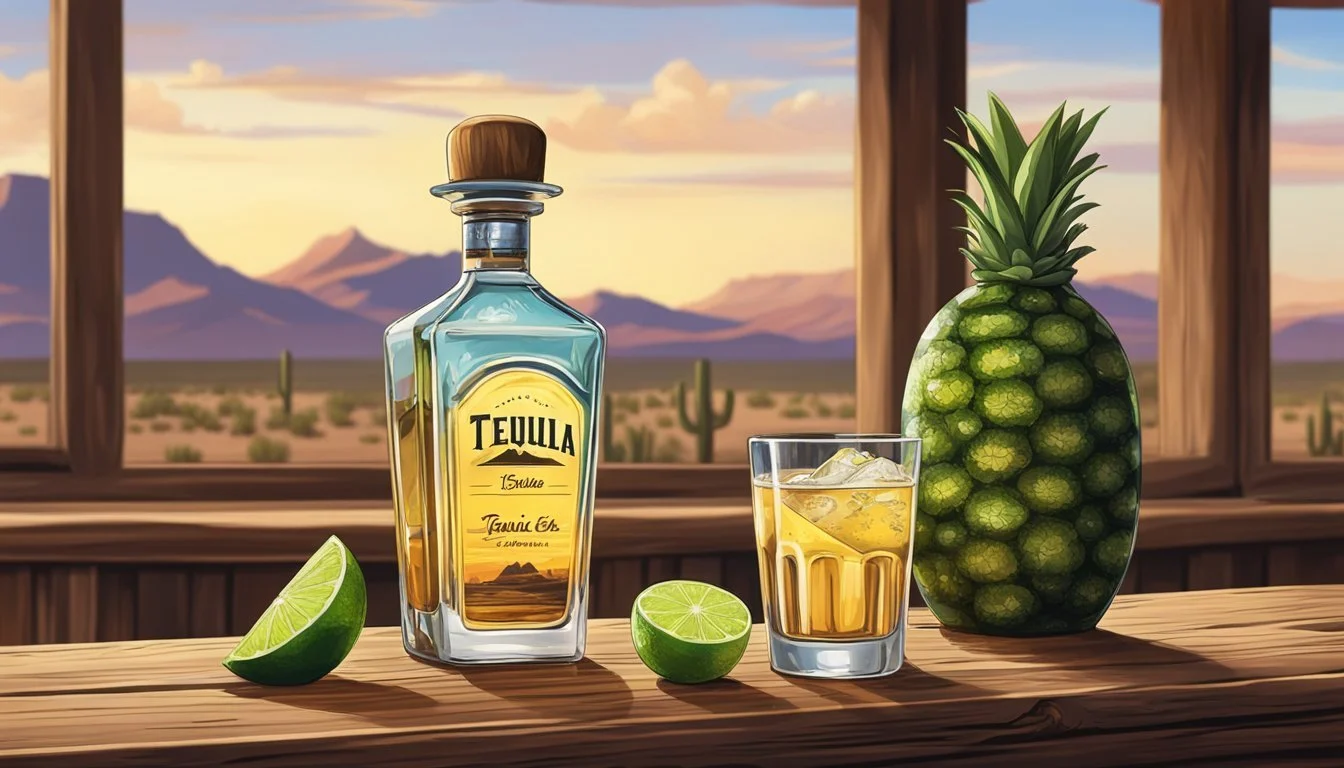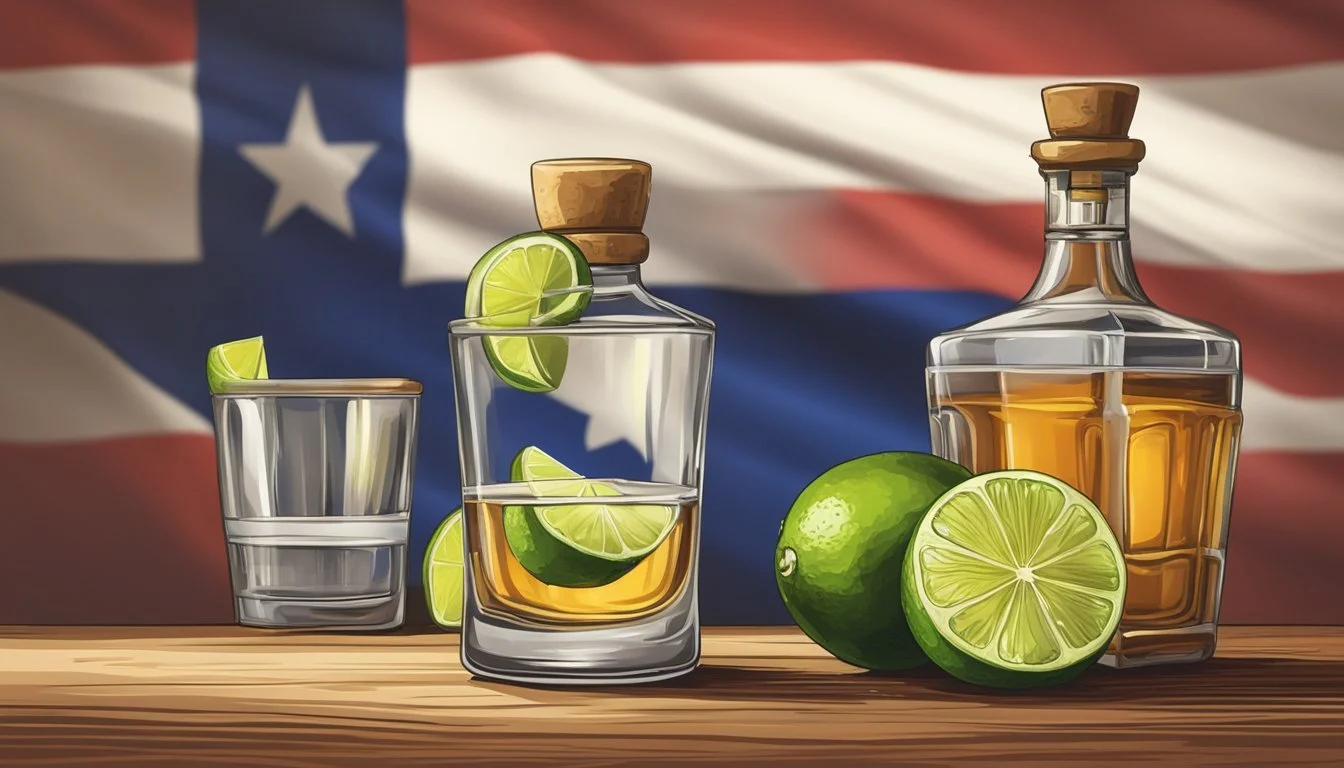The Tequila Last Word
Unveiling a Texas Bartender's Signature Cocktail
The Tequila Last Word cocktail stands as a testament to the classic's adaptability and the inventive spirit of modern mixology. Traditionally, the Last Word is an equal-parts cocktail blending gin, green Chartreuse, Maraschino liqueur, and lime juice—a mix that conjures a harmonious balance of herbal, sweet, and tart flavors. However, in the hands of a Texas bartender, this Prohibition-era libation takes on a new identity, embracing the southwestern love for tequila. By substituting gin with blanco tequila, a fresh agave twist is introduced to the vintage recipe, offering cocktail aficionados a delightful sip that echoes the original's complexity with a decidedly Texan flair.
In bars across the Lone Star State and beyond, this tequila-fueled iteration retains the essence of what made the Last Word a staple of the cocktail canon. The interplay between the smoky undertones of tequila and the potent, verdant notes of green Chartreuse generates a dynamic flavor profile. The Maraschino liqueur brings a subtle cherry sweetness, which, layered with the fresh zing of lime juice, creates a cocktail experience that's both refreshing and sophisticated. This nuanced blend appeals to a broad audience, from cocktail purists to those seeking a spirited escape on the rocks.
The reverence for ingredients in the Tequila Last Word mirrors the meticulous care that defines authentic cocktail craftsmanship. This version's respectful nod to its root recipe coupled with a bold regional twist has earned it a place in the hearts of bartenders and patrons alike. As it graces cocktail menus, the Tequila Last Word is not only a favorite of Texas bartenders but also a shining example of how classic cocktails can evolve, integrating new ingredients while honoring their storied pasts.
Tequila 101
In exploring the world of tequila, one must appreciate its rich heritage, the meticulous categorization of its types, and the botanical intricacies of its primary ingredient—the agave plant.
Types of Tequila
Tequila is distilled from the blue Weber agave plant and comes in three main types: blanco, reposado, and añejo. Each type represents a different aging process and flavor profile.
Blanco tequila, also known as silver tequila, is bottled immediately after distillation or aged up to two months. It offers a pure taste of the agave plant.
Reposado tequila is aged between two months and one year. This aging imparts a smoother flavor with subtle oak notes.
Añejo tequila is aged from one to three years, giving it a complex and smooth flavor, often with hints of vanilla and caramel from the extended contact with wood.
History of Tequila in the U.S.
Tequila first entered the United States in significant quantities during the early 20th century, with its popularity receiving a boost post-Prohibition. It has since risen to prominence alongside the cocktail culture, finding its way into classic drinks and innovative mixology.
Understanding Agave
The blue Weber agave, native to Jalisco, Mexico, is the sole plant authorized for producing tequila. Agave plants take between 7 to 10 years to fully mature before harvest. The volcanic soils of Jalisco's lowlands contribute to a spicier and more robust agave flavor, which, in turn, infuses character and depth into the resulting tequila. Agave spirits, including tequila, reflect the terroir of the region much like fine wines.
Fundamentals of Mixology
Before one dives into creating cocktails, like the tantalizing Tequila Last Word, understanding the fundamentals of mixology is essential. This includes the artistry behind crafting a cocktail and the science of flavor balance.
The Art of Cocktail Making
The creation of a cocktail is an intricate process that involves a keen understanding of various techniques. For instance, bartenders must be adept at shaking—ideal for mixing ingredients quickly to create a uniform blend—or stirring, which is best suited for cocktails that require a delicate touch. These methods not only mix but also dilute the cocktail to the desired strength.
Techniques such as layering and muddling —pressing ingredients to release flavors—are also part of the bartender’s repertoire. Such skills allow the bartender to extract the full spectrum of flavors, as seen in the Tequila Last Word, where muddled lime brings forth a zesty edge that complements the other components.
Balancing Flavors
Flavor balance is paramount in cocktail making. Here's a snapshot of how a bartender achieves this:
Component Role Example
Sour (Acidity) Adds brightness, contrast Lime Juice
Sweet Balances sourness, adds body Simple Syrup
Bitter Depth, complexity Aperitifs, Bitters
Alcohol Base and character Tequila
A well-crafted cocktail like the Tequila Last Word relies on a harmonious blend of flavors. The sourness of lime juice must be carefully calibrated with the sweetness of simple syrup to ensure that no single element overpowers another. The goal is to achieve a rounded, enjoyable sip that invites another. Through practiced mixology, bartenders create cocktails that are more than the sum of their parts, crafting an experience with each glass.
The Last Word Cocktail
The Last Word is an iconic cocktail known for its balance of gin and citrus, with a history stretching back to Prohibition-era America. It's evolved over time and has inspired numerous variations.
Origin and Evolution
The Last Word is a Prohibition-era cocktail that originated at the Detroit Athletic Club in the early 1920s. Frank Fogarty, a vaudeville performer, is often credited with introducing the cocktail. The original Last Word is a precise mix of gin, Green Chartreuse, maraschino liqueur, and lime juice in equal parts. This combination creates a tart and slightly sweet flavor profile that's been revived in modern cocktail culture.
Variations and Recipes
Variations of The Last Word maintain the original's balance while introducing new flavors. An iteration known as the Tequila Last Word replaces gin with tequila, adding a Mexican twist to this American classic.
Classic Last Word:
Ingredient Amount
Gin .75 oz
Green Chartreuse .75 oz
Maraschino Liqueur .75 oz
Lime Juice .75 oz
Tequila Last Word:
.75 oz blanco or reposado tequila
.75 oz Green Chartreuse
.75 oz maraschino liqueur
.75 oz lime juice
To make either variation, one should shake the ingredients with ice until well-chilled and then strain into a chilled coupe glass. The addition of simple syrup is optional in the tequila variant to soften the edges for those who prefer a slight sweetness. This cocktail continues to be a favorite in the repertoire of bartenders and enthusiasts alike.
Advanced Bartending Techniques
Before delving into the intricacies of crafting an exceptional Tequila Last Word, it is essential to understand how advanced bartending techniques enhance the quality and flavor of cocktails, particularly when working with tequila.
The Use of Tequila
When bartenders opt for tequila as a base spirit in their cocktails, they prioritize its unique flavor profiles that range from the peppery notes of a Blanco to the mellow smoothness of an Añejo. Tequila adds a complex character that can transform traditional recipes into signature drinks. For instance, in a Tequila Last Word, the tequila choice directly impacts the cocktail's depth, with many bartenders preferring a Reposado tequila for its balanced oak and agave notes.
Crafting the Perfect Margarita
A bartender's skill is often measured by their ability to make a Margarita—a cocktail that appears simple yet demands precision. The perfect Margarita strikes a balance between sour and sweet, leveraging freshly squeezed lime juice and high-quality simple syrup. Measure carefully:
2 ounces Tequila (preferably Reposado)
1 ounce lime juice
3/4 ounce simple syrup or orange liqueur
Ice
Salt for rimming (optional)
Shake the ingredients vigorously with ice and strain into a glass rimmed with salt. The shake not only chills but also aerates the cocktail, adding to its texture.
Innovative Citrus Pairings
Exploring beyond lime, bartenders often incorporate other citrus fruits to add a twist to classic tequila drinks. Grapefruit juice, for example, can lend a pleasingly bitter note and pair well with the sweet and invigorating profile of tequila. One can innovate by introducing a grapefruit soda or a freshly made grapefruit sherbet into their Margaritas or Palomas. These fruity and sour components, when balanced correctly, result in a refreshing cocktail with layers of complexity.
The Tequila Last Word
A Texas bartender elevates the classic Last Word cocktail by substituting gin with tequila. This variation not only respects the cocktail's traditional balance but also infuses a unique, agave-forward twist.
Recipe and Preparation
Ingredients:
1 oz. blanco tequila
3/4 oz. Green Chartreuse
1/2 oz. maraschino liqueur
3/4 oz. fresh lime juice
Instructions:
Fill a mixing glass with ice.
Pour the blanco tequila, Green Chartreuse, maraschino liqueur, and fresh lime juice into the glass.
Stir the mixture until well-chilled.
Strain the cocktail into a chilled coupe glass.
This preparation pays homage to the precision of the original Last Word while showcasing the dynamic character of tequila.
Taste and Flavor Profile
The Tequila Last Word is characterized by a harmonious blend of flavors:
Tequila: The use of blanco tequila introduces a crisp, clean taste with subtle notes of agave.
Citrus: Fresh lime juice offers a bright, sour element that complements the strength of the spirits.
Green Chartreuse: This herbal liqueur contributes a complex, sweet undertone.
Maraschino Liqueur: Adds a delicate sweetness and rounds out the cocktail with its rich flavor.
This drink presents a balanced, refreshing experience, with the citrus tang of lime accentuating the tequila's profile and the maraschino liqueur offsetting the herbal qualities of the Chartreuse.
Tequila's Global Influence
Tequila, the iconic Mexican spirit, has crossed domestic borders and engrained itself in diverse cultures, boasting significant recognition on the global stage.
Popularity Beyond Borders
In cities like Houston, Chicago, and San Francisco, tequila has become a celebrated choice among distilled spirits. Its rise in popularity can be seen through its impressive sales figures and the prevalence of tequila-based cocktails in bars and restaurants across these urban hotspots.
According to the Distilled Spirits Council of the United States, tequila sales showed a notable increase, with a 5.7 percent rise in volume, equating to 31.6 million cases. Financially, this growth translated to a staggering 7.9 percent revenue increase, adding an estimated $476 million to the industry.
What began as a regional specialty in Mexico, tequila is now a permanent fixture in the global liquor market, solidifying its status as a spirit that transcends cultural and geographic limits.
Cultural Significance
The Tequila Last Word cocktail not only showcases tequila's versatility in modern mixology but also asserts its enduring status as a cultural emblem within the beverage realm.
Tequila in Modern Cocktails
Modern mixologists frequently celebrate tequila for its unique flavor profile, which ranges from the robust and smoky notes of mezcal to the crisp and clean tones of Tequila Ocho Plata. In the context of contemporary cocktails, tequila brings a depth that complements a variety of ingredients, creating innovative variations of classic drinks. For instance, the Margarita and Paloma highlight tequila’s ability to balance sweet, sour, and bitter components, often utilizing freshly-squeezed lime juice and grapefruit soda respectively. The drinks are then often produced using the traditional tahona process, which involves crushing the agave plant with a stone wheel, imparting a distinct artisanal quality to the spirit.
Popular Tequila Cocktails:
Margarita: Tequila, lime juice, triple sec, and optional sweetener
Paloma: Tequila, grapefruit soda, lime juice, and a pinch of salt
Tequila Last Word: Tequila, Green Chartreuse, Maraschino liqueur, and lime juice
Tequila as a Cultural Icon
Tequila's journey from Mexican agricultural staple to global icon is a testament to its cultural significance. Originally derived from the agave plant — sacred to the Aztecs for its purported divine origins — tequila has transcended its geographic roots. It stands as a symbol of Mexican heritage while being flexibly adopted by various cultures, signifying celebration and community. The spirit's heritage is protected; it is a designation of origin product, meaning true tequila can only be produced in certain Mexican regions, ensuring its authenticity and economic significance to its home country.
Buying Guide
When crafting the perfect Tequila Last Word, the selection of tequila is paramount. Understanding the types of tequila and their flavor profiles, as well as recognizing quality brands, will elevate the cocktail experience.
Selecting the Right Tequila
The foundation of a Tequila Last Word is crucial, and it starts with choosing the correct type of tequila: blanco, reposado, or añejo. Each brings a distinct character to the cocktail:
Blanco Tequila: Unaged and bottled shortly after distillation, it offers a pure, crisp agave flavor. It's ideal for those who appreciate a vibrant, clean taste in their cocktails.
Reposado Tequila: Aged in oak barrels for two to twelve months, it strikes a balance between the freshness of blanco and the complexity of añejo. Reposado brings a subtle smoothness with hints of vanilla and oak.
Añejo Tequila: Aged longer, between one to three years, añejo tequila imparts richer, deeper flavors of caramel and spice. It contributes a luxurious element to the cocktail but can overshadow other ingredients if not balanced well.
Look for tequilas displaying 100% blue agave as a hallmark of quality.
High-Quality Brands and Varieties
A Tequila Last Word calls for a tequila that can complement the cocktail's other components while standing out on its own. While specific names like Don Julio and Tequila Ocho Blanco are renowned among enthusiasts, it is important to recognize characteristics that signal high-quality tequila across various brands:
Feature Description
Region Tequilas from specific regions, such as Jalisco, have a reputation for quality due to the area's
optimal conditions for growing agave.
Aging Process Note whether the tequila has an aging statement and the type of barrel used, as this will affect
the flavor. Oak barrels are often preferred for their notes.
ABV Alcohol By Volume (ABV) can range from about 35% to 55%. Consider the balance in the cocktail
when selecting a higher proof tequila.
Remember that preferences may vary, so selecting a high-quality tequila that suits one's palate is essential while ensuring it complements the cocktail's overall harmony.
Home Bartending Essentials
To master the art of the Tequila Last Word and other tequila-based cocktails at home, one must ensure their home bar is properly equipped with essential tools and ingredients.
Equipping Your Home Bar
When setting up a home bar, a discerning bartender should prioritize acquiring the right tools. An inventory list for a well-appointed home bar must include:
Glassware: Cocktail, highball, and margarita glasses.
Shakers: For blending ingredients smoothly.
Jiggers: For precise measurement of spirits and mixers.
Strainer: To separate solids from liquids after shaking or stirring.
Muddler: For crushing herbs or fruit to release flavors.
Bar Spoon: For stirring and layering drinks.
Citrus Juicer: To extract fresh juice for cocktails.
Tequila enthusiasts should choose quality tequila that reflects their flavor preferences, whether it be blanco, reposado, or añejo.
Tequila Cocktails at Home
Tequila is not just for margaritas; it serves as a versatile base for a wide range of cocktails. Understanding the flavor profile of different types of tequila can elevate the home bar experience. Here are key ingredients for tequila-based cocktails:
Tequila: Blanco for crisp, clean flavors, or aged variants for depth.
Cointreau: A common orange liqueur in many tequila cocktails.
Lime Juice: Fresh is best for a bright, tart element.
Simple Syrup: To balance out the acidity and add sweetness.
Agave Syrup: A natural sweetener that complements tequila's flavors.
By honing their craft with the correct tools and quality ingredients, any home bartender can confidently create and serve exquisite tequila cocktails.









